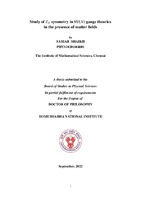- DSpace Home
- →
- IMSc Theses/ Dissertations
- →
- IMSc Theses/ Dissertations
- →
- View Item
JavaScript is disabled for your browser. Some features of this site may not work without it.
| dc.contributor.author | Sabiar Shaikh | |
| dc.date.accessioned | 2023-05-16T09:58:40Z | |
| dc.date.available | 2023-05-16T09:58:40Z | |
| dc.date.issued | 2023 | |
| dc.date.submitted | 2022-09 | |
| dc.identifier.uri | https://dspace.imsc.res.in/xmlui/handle/123456789/615 | |
| dc.description.abstract | In this thesis, we study the confinement-deconfinement (CD) transition and the Z 3 symmetry in SU(3)+Higgs theory in 3 + 1 dimensions, using non-perturbative lattice Monte Carlo simulations. In particular, we study the cut-o↵ e↵ects on the CD transition and the Z 3 symmetry by varying the number of lattice sites in the temporal direction (N ⌧ ). The Higgs field is considered to be in the fundamental representation. It is found that for N ⌧ = 2 the CD transition is a continuous, along with a large explicit breaking of the Z 3 symmetry. With the increase in N ⌧ the strength of the CD transition increases, while the strength of explicit breaking decreases. Our results suggest that the explicit breaking is vanishingly small in the N ⌧ ! 1 limit. In this limit, the CD transition is first order as that in the case of pure SU(3) gauge theory. Similar results were also observed inSU(2)+Higgs. These results are rather surprising since as long as the masses of the matter fields are finite, the Euclidean action breaks the Z 3 symmetry. To understand the realization of Z N symmetry in the N ⌧ ! 1, we consider a one dimensional gauged chain of matter fields. As in SU(N) gauge theories with matter fields in the fundamental representation in 3 + 1 dimensions, the action breaks Z N symmetry explicitly. The analytic calculation of the partition function shows that the Z N symmetry is realized in the continuum limit for a gauged chain of bosonic matter fields. To further probe the reason behind the realisation of Z N symmetry we consider a simple model of Z 2 +Higgs theory in both 3+1 and 0+1 dimensions where it is shown that the density of states (DoS) exhibits Z 2 symmetry. As the DoS dominate the thermodynamics over the Boltzmann factor in the partition function, for a large number of temporal lattice sites and in the Higgs symmetric phase, the Z 2 symmetry is realized. | en_US |
| dc.publisher.publisher | The Institute of Mathematical Sciences | en |
| dc.title | Study of Z N symmetry in SU(N) gauge theories in the presence of matter fields [HBNI Th 224] | en_US |
| dc.type.degree | Ph.D | en_US |
| dc.type.institution | HBNI | en_US |
| dc.description.advisor | Sanatan Digal | |
| dc.description.pages | 115 p | en_US |
| dc.type.mainsub | Physics | en_US |
| dc.type.hbnibos | Physical Sciences | en_US |
Files in this item
This item appears in the following Collection(s)
-
IMSc Theses/ Dissertations
IMSc Theses/ Dissertations
